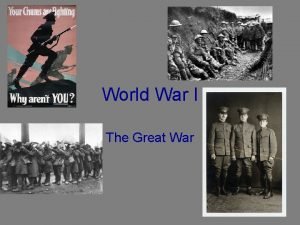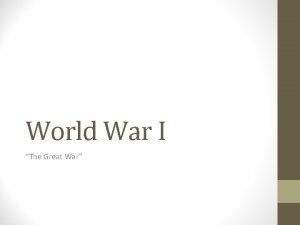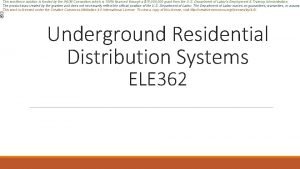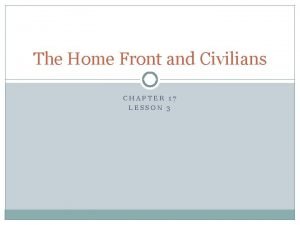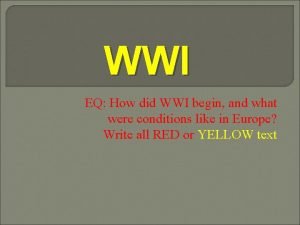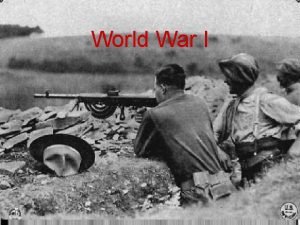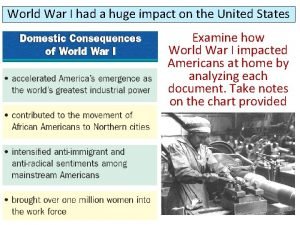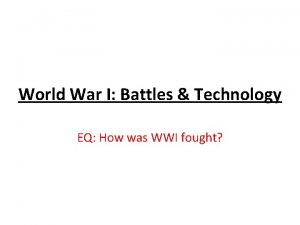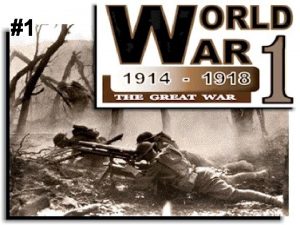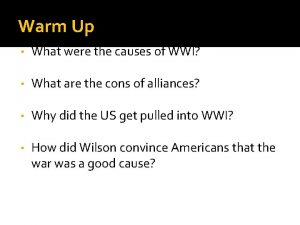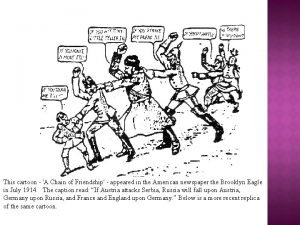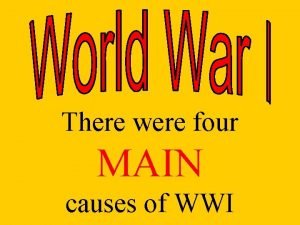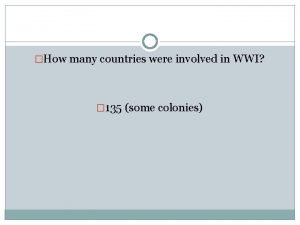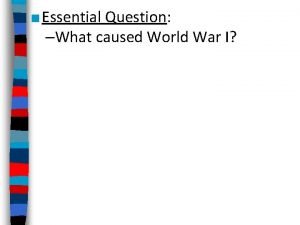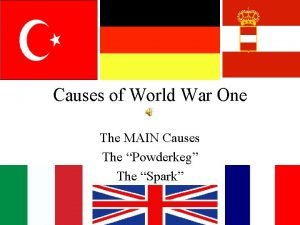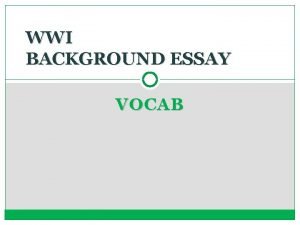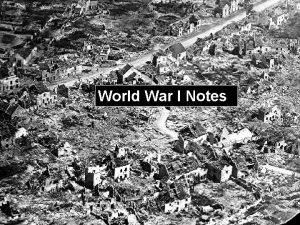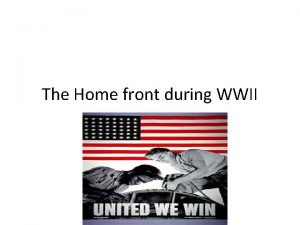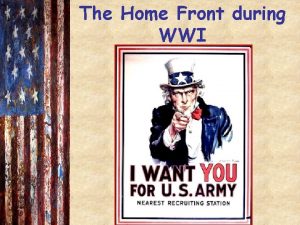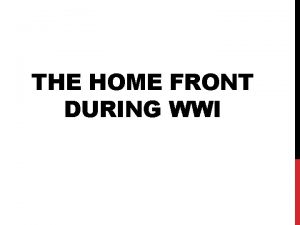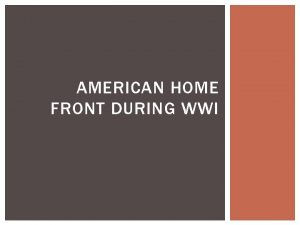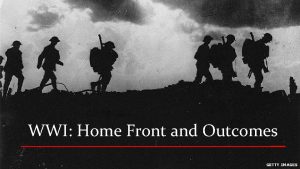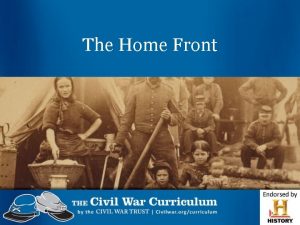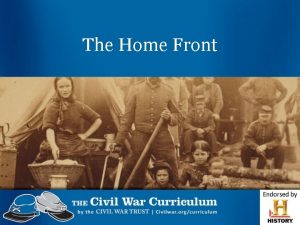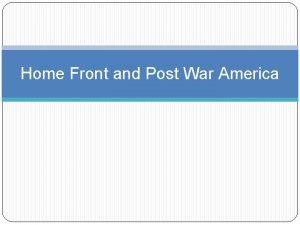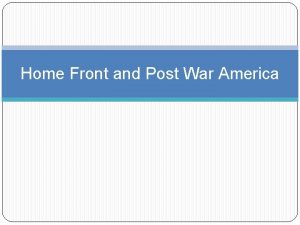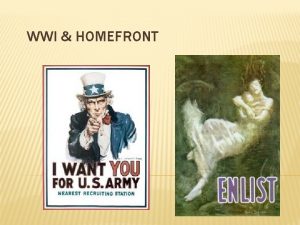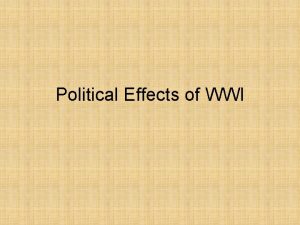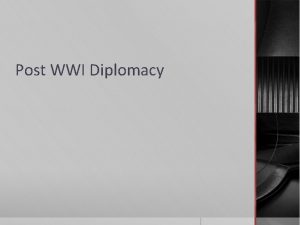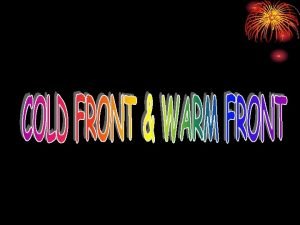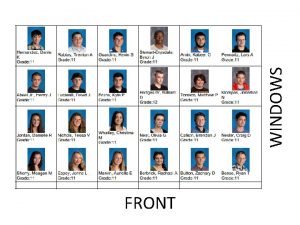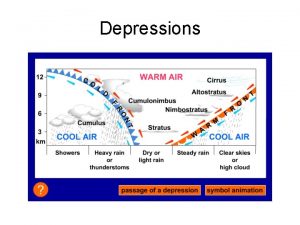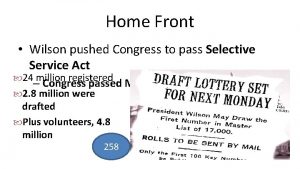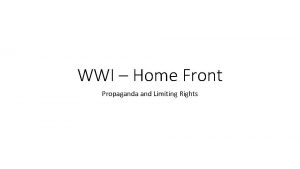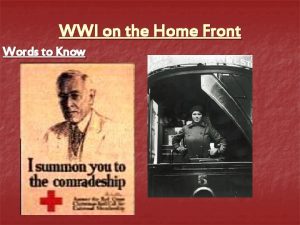The Home Front during WWI Selective Services Act


































- Slides: 34

The Home Front during WWI


Selective Services Act • Introduced Draft / Conscription: by lottery • Men aged 21 -30, later 18 -45 • 2 m drafted, 2 m volunteers • Segregation of Armed Forces continued …until the Korean War • AEF: American Expeditionary Forces - John J. Pershing – name given to our forces in WW 1

1917 Selective Service Act 24, 000 men registered for the draft by the end of 1918 4, 800, 000 men served in WWI (2, 000 saw active combat) 400, 000 African-Americans served in segregated units 15, 000 Native-Americans served as scouts, messengers, and snipers in non-segregated units

• Nicknamed “Doughboys” • US troops not effective until late 1917, early 1918 • US troops had a huge impact on crucial victories over Germans at Chateau Thierry, Rheims, Argonne Forest • Death toll: 57, 000 American troops died of influenza in Europe during the War, 53, 000 died on the battlefield…total 110, 000

Mobilization Gathering of resources and the preparation for war affected every part of American life National War Labor Board Created to ensure the most basic demands of workers were met so production for war went unaffected 8 Hour working day Overtime pay Equal pay for women

Opportunities for African Americans during WWI War industries work The Great Migration 1914 -1920 300, 000 -500, 000 African American moved to Northern cities from the rural South to find job in factories Enlistment in segregated units

The Role of Women in WWI Women in the military Army sent 30, 00 women overseas as nurses Navy employed women in clerical positions

Financing the War • First estimates were $10 b would be needed: eventual costs grew to $32 b • Funded by: • Liberty Bonds, at 4% interest, sold by Sec. of Treasury William Mc. Adoo, brought in $23 b • Increased income tax, and new Corporate taxes brought in $10 b

Organizing the Economy • At first Wilson set up Regional planning authorities to control transport, war production, food production – were not effective • Changed to centralized, national authorities / boards • National Railroad Board: co-ordinate nation’s train system into a single unified system…trunk lines, co-operation of RR companies demanded to ensure the flow of goods from West to East

Food Administration “Wheatless Mondays” “Meatless Tuesdays” “Porkless Thursdays”


Producing Supplies Government encouraged farmers to produce more and civilians to eat less Food Administration Encouraged voluntary rationing War Industries Board Managed factories in transition



“V” is for Victory (Garden that is!)

• Voluntary consumer conservation through “wheat-less Mondays” and “meatless Tuesdays” campaigns: gov. encouraged the public to grow their own crops / vegetables in “Victory Gardens” (yards, parks. . ) – great success • War Industries Board: under Bernard Baruch: controlled huge Govt. contracts for war materials: persuaded industries to convert to producing war goods (from cars to tanks – Henry Ford, shoes to army boots, clothes to army uniforms) • Industry was again allowed to form huge trusts and monopolies: Progressive anti-trust legislation was suspended; many of the gains of the Progressive years were undone…trusts / monopolies were fast and efficient in providing for the gov’s needs


Fuel Administration

• Fuel Administration: headed by Harry Garfield: goal was to increase fuel and energy supplies (coal, oil, electricity, natural gas ), encourage voluntary consumer reduction – leaving more for war effort (produce more, consume less) • Public was encouraged to save fuel through campaigns such as “heatless Mondays” and “lightless nights” and “gasless Sundays” – great success • Food Administration: headed by Herbert Hoover: had already led food drive for Belgium: increase food supply, less public consumption: bigger surplus for war effort: (again, produce more, consume less)

Committee on Public Information

• National War Labor Board: type of supreme court for labor disputes, mediator to prevent disruption of industry / strikes, esp. essential war industries. Samuel Gompers was a Board member • Persuaded many employers to increase wages, this was often offset by inflation – though for many workers over-time opportunities were unlimited • There were still many strikes during 1917 -1918, but the NWLB prevented many more from breaking out

• Overall – these authorities were a great success in restructuring the Economy to satisfy the needs of the War – National Railroad Board – Fuel Administration – Food Administration – War Industries Board – National War Labor Board

Controlling Public Opinion Even after American entered the war, opposition to it remained strong Committee on Public Information Began trying to scilence war disagreement or opposition

Propaganda, Repression. . • The gov. set up the Committee of Public Information (CPI): to control Propaganda and Media: under George Creel: Distributed pro-war literature: 75 m pieces: posters, leaflet etc. • Employed “four minute men” who delivered patriotic speeches in factories, clubs, sports events • Promoted war efforts, campaigns of Fuel and Food Board, War Bonds, encouraged women to work in industry and business…

• Encouraged newspapers to engage in “self – censorship” about negative war information • Encouraged people to spy on their neighbors and inform authorities if they saw disloyalty • Espionage Act: 1917: imposed heavy fines and jail sentences on anyone convicted of spying, sabotage, or obstruction of war effort: also banned from the US mail system any “seditious material. ”

• Sabotage Act and Sedition Act of 1917: extended Espionage Act to include any public expression of opposition to the war: prohibited disloyal or abusive remarks about the government or president • This “Legal Repression” led to the arrest of 2, 000 people, with 1, 000 imprisoned

Espionage Act – 1917 - forbade actions that obstructed recruitment or efforts to promote insubordination in the military. - ordered the Postmaster General to remove Leftist materials from the mail. - fines of up to $10, 000 and/or up to 20 years in prison.

How far are YOU willing to go for your country? Sedition Act – 1918 - it was a crime to speak against the purchase of war bonds or willfully utter, print, write or publish any disloyal, profane, or abusive language about this form of US Govt. , the US Constitution, or the US armed forces or to willfully urge, incite, or advocate any curtailment of production of things necessary or essential to the prosecution of the war…with intent of such curtailment to cripple or hinder the US in the prosecution of the war.

• Wilson anticipated and feared this violation of Civil Rights and Liberties during the War – he realized that war usually brought intolerance and repression (Civil War) • The IWW and Socialist Party were targeted for their vocal opposition to the war: William Haywood was forced to flee and Eugene V. Debs was arrested and imprisoned on several occasions • The CPI also encouraged “Popular Repression”: vigilante groups set up Loyalty Leagues such as the American Protective League, and took it upon themselves to “discipline” people who opposed involvement in the War – members engaged in spying, opening mail, tapping phones, physical attacks / beatings

• Through “Popular Repression” Immigrant groups – Irish, Germans, Jewish – were targeted: German. Americans suffered most • Huge anti – German campaign: Discouraged affiliation with German Music (Beethoven, Wagner), Food (sauerkraut became “liberty cabbage” and hamburger became “liberty sausage”), Language, Books • German-Americans were harassed (evidence of one murder at least), and some were fired from their jobs

• “In the process of uniting public opinion behind the war, the civil liberties and civil rights of many people were interfered with. The US had once again shown its inability to tolerate criticism of official government policy. ” (Bailyn) • Legal and Popular Repression was opposed by the American Civil Liberties Union (ACLU) which set out to “give assistance to pacifists and conscientious objectors (religious objections)”

• After the war the Supreme Court considered the legality of gov. policy in Schenck v US • Schenck was General Secretary of the Socialist Party: he was convicted and imprisoned for distributing anti war literature…for violating the Espionage, Sabotage, Sedition Acts; took the gov. to court after the war for violating his constitutional rights to freedom of speech, press… • Supreme Court / Chief Justice Holmes ruled that in time of “Clear and Present Danger” the civil rights and liberties of the Constitution could be suspended (same decision after WWII / Japanese Americans)

• He used the analogy of someone yelling “Fire” in a public movie theatre and thereby endangering the lives of all those at the movie (not that appropriate? ) – that a person’s freedom of speech, to yell “fire” clearly and presently endangered the lives of the other moviegoers and so should be suspended….
 Side effects of propranolol
Side effects of propranolol Ww1 map eastern front
Ww1 map eastern front Selective service act of 1917
Selective service act of 1917 Macbeth summary
Macbeth summary Dead front vs live front transformer
Dead front vs live front transformer Draw the symbol for a cold front
Draw the symbol for a cold front School magazine cover
School magazine cover Lesson 3 the home front and civilians
Lesson 3 the home front and civilians Tuskegee airmen apush
Tuskegee airmen apush Arti homecare
Arti homecare Perbedaan home care dan home visit
Perbedaan home care dan home visit New mobile home sales oak springs mobile home community
New mobile home sales oak springs mobile home community Flower plural
Flower plural Softly and tenderly jesus is calling
Softly and tenderly jesus is calling Oak springs rv park
Oak springs rv park Let's go to my house
Let's go to my house Arman home sweet home
Arman home sweet home She said that, home economics stands for the ideal home.
She said that, home economics stands for the ideal home. Home sweet home survival
Home sweet home survival Ww1 webquest answer key
Ww1 webquest answer key Triple alliance ww1 map
Triple alliance ww1 map Europe map before ww1
Europe map before ww1 Wwi causes main
Wwi causes main Impact of wwi
Impact of wwi New technology in wwi
New technology in wwi Causes of nationalism
Causes of nationalism World war i combatants
World war i combatants The chain of friendship ww1 explained
The chain of friendship ww1 explained Simulateries
Simulateries Imperialism in 1900
Imperialism in 1900 How many countries were involved in wwi
How many countries were involved in wwi Nationalism in europe
Nationalism in europe Cause of ww1
Cause of ww1 Wwi background
Wwi background Mania world war i
Mania world war i

